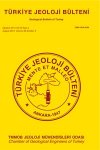
-
2025
-
2024
-
2023
-
2022
-
2021
-
2020
-
2019
-
2018
-
2017
-
2016
-
2015
-
2014
- 2013
-
2012
-
2011
-
2010
-
2009
-
2008
-
2007
-
2006
-
2005
-
2004
-
2003
-
2002
-
2001
-
2000
-
1999
-
1998
-
1997
-
1996
-
1995
-
1994
-
1993
-
1992
-
1991
-
1990
-
1989
-
1988
-
1987
-
1986
-
1985
-
1984
-
1983
-
1982
-
1981
-
1980
-
1979
-
1978
-
1977
-
1976
-
1975
-
1974
-
1973
-
1972
-
1971
-
1970
-
1969
-
1968
-
1966
-
1964
-
1963
-
1961
-
1959
-
1958
-
1955
-
1954
-
1953
-
1952
-
1951
-
1950
-
1949
-
1948
-
1947
Abstract: This study aims to investigate facies and microfacial properties of the Karaisalı Formation (BurdigalianAkitanian) cropping out in the northern and northwestern parts of the Neogene aged Adana Basin.The Karaisalı Formation is mostly composed of white-cream coloured massive reefal limestones withalga, coral, gastropod, lamellibranch, and echinoid. In the study area, three facies and nine microfacieshave been delineated based on geometry, lithology and fossil content. These facies and microfaciesrepresent: reef core (1- coralline framestone microfacies, 2- red algal- coralline bindstone/framestonemicrofacies, 3- foraminiferal- algal fragment bearing packstone/wackestone); reef front (4- large benthicforaminiferal- algal packstone microfacies, 5- Operculina packstone microfacies); back reef (6- small benthic foraminiferal-algal packstone microfacies, 7- small benthic foraminiferal- algal wackestonemicrofacies, 8- bioclastic wackestone- mudstone microfacies, 9- local red algal bindstone microfacies)environments.
Abstract: The study area is situated in the Ağcakışla (Şarkışla) area of the western edge of the Sivas Basin which isone of the major Tertiary basins of Central Anatolia. The Tokuş Formation, which is the subject of this study, begins with conglomerate at the base, and constitutes with pebbly sandstone and coarse-grained sandstone.The unit consists of limestone with Alveolina and Nummulites and marl with planktonic foraminifera. Thebenthic foraminifera such as Alveolina minuta Checchia-Rispoli, Alveolina schwageri Checchia-Rispoli,Alveolina seni Sirel and Acar, Alveolina archiaci Sirel and Acar, Alveolina cremae Checchia-Rispoli,Alveolina cremae elongata Sirel and Acar, Alveolina tenuis Hottinger, Alveolina fusiformis Sowerby,Alveolina aff. callosa Hottinger, Alveolina aff. colatiensis Drobne, Orbitolites complanatus Lamarck,Fabiania cassis (Oppenheim), Gyroidinella magna (Le Calvez), Sphaeorogypsina globulus (Reuss),Asterigerina rotula (Kaufmann), Lockhartia hunti Ovey, Lockhartia tipperi (Davies), Assilina exponens(Sowerby), Nummulites deshayesi DArchiac, Nummulites aturicus (Joly and Leymerie), Nummulitesperforatus (De Montfort) and Discocyclina sp. were described. According to fossil assemblage, CuisianBartonian age was given, and shallow benthic foraminifera biozones (SBZ) were described.
Abstract: The study area covers volcanic-volcanosedimentary units of Eocene age in the Sivas-Ulaş area. Thepyroclastic (tuffaceous claystone / siltsone / sandstone, crystal ash tuff) and volcanic (basalt, basalticandesite, andesite) rocks of the Karacalar member from Kaleköy formation include volcanogenic(plagioclase, augite, hornblende, biotite), diagenetic (K-feldspar, mixed-layered chlorite-smectite / C-S,chlorite, smectite, analcime) and post-volcanic (calcite, dolomite, quartz) minerals. The volcanogenic(plagioclase), diagenetic (K-feldspar, C-S, chlorite, smectite), post-volcanic (quartz, calcite, dolomite) anddetrital (illite) minerals were observed in the epiclastic (shale, siltstone, calcareous siltstone, sandstone, calcareous sandstone) and chemical (limestone, gypsum) rocks of the Yapalı member from this formation.C-S and chlorite amounts increase, but illite content decreases in the vertical direction of the formation.C-S + K-feldspar zoning is widely developed by due to the interaction between sea-water and volcanicglass in basic-intermediate composition, on the basis of optic and electron microscopes and also X-raysdata. This zone corresponds to the deeper parts of the Sivas basin in the Eocene period and show verticallya transition in zeolite zone in approximately northern parts of the basin (Yavu area).
Abstract: This article informs the retirement of a hardworking researher (İlhan Kayan) and it reviews the memorybook for his name.

 TMMOB
TMMOB